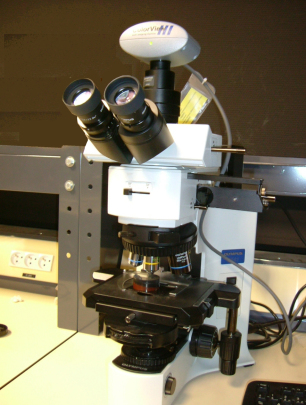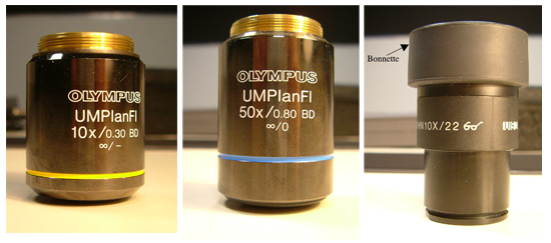Presentation
The photography on figure 22 represents a professional microscope allowing the observation of opaque objects by reflexion using its episcopic Köhler illumination system. This high quality microscope works with infinity-corrected objectives and has a “trinocular” head allowing for a comfortable binocular observation together with high-quality photomicrography using the dedicated output equiped with a projective ocular.

Figure 23 shows photographs of two objectives and one eyepiece of this system:

One can note the correction \(\infty /0\)for the objective \(50\times /0.80\), indicating that it is designed to work with a tube lens (\(\infity\)) and without a coverslip (0), which is classical in episcopic microscopy. The indication \(50\times\) represents the total magnification for the ensemble objective/tube lens. The indication \(\infty /–\) for the objective \(10\times /0.30\) means that it is also corrected for a 'infinite tube length'; nevertheless, its relatively small object-side numerical aperture (of \(0.3\)) allows it to be used with or without coverslip. The two objectives, of model UM Plan Fl, belong to the class Plan-Achromatic designed for a universal metallographic (UM) use; the mention Fl indicates that they are specifically designed to be used in the near-ultraviolet thanks to the use of specific glasses (such as fluorine) transparent in this wavelength range and of very small intrinsic fluorescent (autofluorescence). The eyepiece \(10\times /22\) has an angular magnification factor of \(10\), and is designed to observe an intermediate image of \(22~mm\). It is specifically designed to be used comfortably by an observer wearing eyeglasses (after folding the rubber eyecup), which means that the eye relief (the distance between the last ocular surface and the microscope exit pupil plane) is on the order of \(25~mm\).